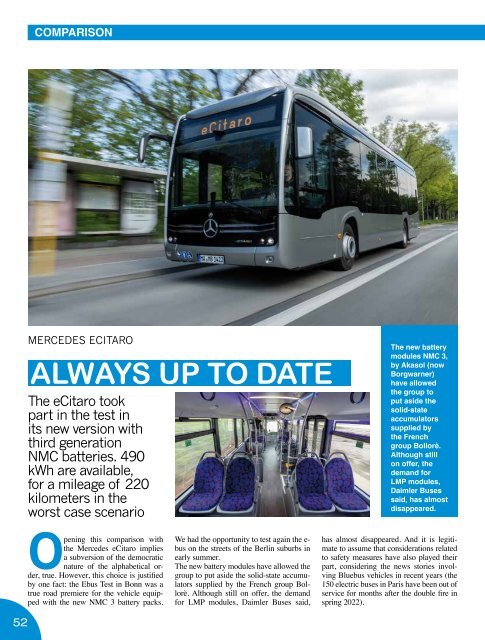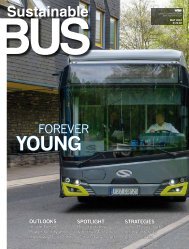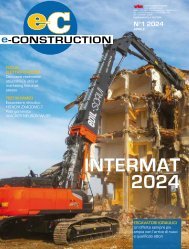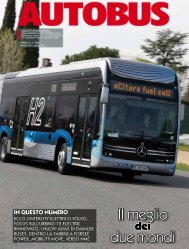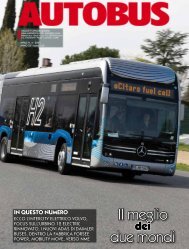2023-09 SUSTAINABLE BUS
A new issue of Sustainable Bus is out today. In this upcoming edition, we’ve curated a diverse and comprehensive range of topics that spotlight the latest developments in the world of sustainable mobility. From cutting-edge technological advancements to market insights and industry transformations, this issue promises to be a captivating exploration of the future of public transportation. What you could fine inside? Well, a market insight will offer you a detailed look at the European e-bus market, providing you with a comprehensive understanding of the mid-2023 results. The leading e-bus market in Europe is still UK: therefore, we focused our attention on that specific market with a report that sums up strategies, focus, goals of the most prominent industry players. A technology spotlight on the delicate topic of batteries, authored by Claudius Jehle, look at battery management and strategies to ensure the smooth and cost-effective operation of electric buses (with a focus on a case study from BVG). Among the pillars of our upcoming issue you’ll find a detailed journey around the European industrial bus&coach landscape. Goal? Providing our readers insights into the changing dynamics among key OEMs in the region. We’ll be then taking you behind the scenes at the Yutong factory in Zhengzhou, that we had the pleasure of visiting in June. Let’s then delve into Iveco Bus’s growing efforts in the zero-emission bus field. Finally, last but not least, a nearly-20-pages comparison between seven 12-meter battery-electric buses, gathered together in Bonn also this year by the German magazine Omnibusspiegel. You’ll find both established players and newcomers side by side: Ebusco 3.0, Hess lighTram 12m, Ikarus 120e, Iveco E-Way, Mercedes eCitaro with new batteries, Otokar e-Kent C, Quantron Cizaris 12 Ev.
A new issue of Sustainable Bus is out today. In this upcoming edition, we’ve curated a diverse and comprehensive range of topics that spotlight the latest developments in the world of sustainable mobility. From cutting-edge technological advancements to market insights and industry transformations, this issue promises to be a captivating exploration of the future of public transportation.
What you could fine inside? Well, a market insight will offer you a detailed look at the European e-bus market, providing you with a comprehensive understanding of the mid-2023 results. The leading e-bus market in Europe is still UK: therefore, we focused our attention on that specific market with a report that sums up strategies, focus, goals of the most prominent industry players.
A technology spotlight on the delicate topic of batteries, authored by Claudius Jehle, look at battery management and strategies to ensure the smooth and cost-effective operation of electric buses (with a focus on a case study from BVG).
Among the pillars of our upcoming issue you’ll find a detailed journey around the European industrial bus&coach landscape. Goal? Providing our readers insights into the changing dynamics among key OEMs in the region.
We’ll be then taking you behind the scenes at the Yutong factory in Zhengzhou, that we had the pleasure of visiting in June. Let’s then delve into Iveco Bus’s growing efforts in the zero-emission bus field.
Finally, last but not least, a nearly-20-pages comparison between seven 12-meter battery-electric buses, gathered together in Bonn also this year by the German magazine Omnibusspiegel. You’ll find both established players and newcomers side by side: Ebusco 3.0, Hess lighTram 12m, Ikarus 120e, Iveco E-Way, Mercedes eCitaro with new batteries, Otokar e-Kent C, Quantron Cizaris 12 Ev.
Create successful ePaper yourself
Turn your PDF publications into a flip-book with our unique Google optimized e-Paper software.
COMPARISON<br />
MERCEDES ECITARO<br />
ALWAYS UP TO DATE<br />
The eCitaro took<br />
part in the test in<br />
its new version with<br />
third generation<br />
NMC batteries. 490<br />
kWh are available,<br />
for a mileage of 220<br />
kilometers in the<br />
worst case scenario<br />
The new battery<br />
modules NMC 3,<br />
by Akasol (now<br />
Borgwarner)<br />
have allowed<br />
the group to<br />
put aside the<br />
solid-state<br />
accumulators<br />
supplied by<br />
the French<br />
group Bollorè.<br />
Although still<br />
on offer, the<br />
demand for<br />
LMP modules,<br />
Daimler Buses<br />
said, has almost<br />
disappeared.<br />
As known, the structure of the eCitaro is<br />
derived from the internal combustion engine<br />
Citaro. For example, the curved windscreen<br />
is the same as on the Citaro Ü. The<br />
production line is in Mannheim, which has<br />
been indicated by the group as a hub to be<br />
increasingly devoted to e-mobility: starting<br />
from 2024, only electric buses will be<br />
built there.<br />
The bus offered for testing in Bonn features<br />
five battery packs for a total capacity<br />
of 490 kWh. They are divided into three<br />
packs on the roof and two in the rear part<br />
of the bus (a choice which has not yet allowed<br />
Daimler Buses to clear out the engine<br />
tower, which remains to ‘close’ the five-seater),<br />
each with a capacity of 98 kWh (for<br />
598 kilos of weight).<br />
High standards in the cabin<br />
The Ebus Test was taken by a two-door<br />
eCitaro. The doors are both with double<br />
leaf, electric drive and inward movement.<br />
On board there is room for 81 passengers,<br />
31 of whom are seated on City Star Eco<br />
seats developed in-house by the group.<br />
The seats and seatbacks are covered with<br />
fabric. To add a dash of color to the passenger<br />
compartment, there are red handrails<br />
surmounted by blue luminous bands. The<br />
corridor floor is in wood-look PVC. High<br />
quality standards for the interiors, as per<br />
Mercedes tradition. The empty weight is<br />
not the lightest, which has repercussions<br />
on a passenger capacity that is stably 15<br />
percent less than the diesel Citaro. The<br />
new camera system is mounted on the bus,<br />
offering a 360-degree view, to the full benefit<br />
of visibility when maneuvering.<br />
Opening this comparison with<br />
the Mercedes eCitaro implies<br />
a subversion of the democratic<br />
nature of the alphabetical order,<br />
true. However, this choice is justified<br />
by one fact: the Ebus Test in Bonn was a<br />
true road premiere for the vehicle equipped<br />
with the new NMC 3 battery packs.<br />
We had the opportunity to test again the e-<br />
bus on the streets of the Berlin suburbs in<br />
early summer.<br />
The new battery modules have allowed the<br />
group to put aside the solid-state accumulators<br />
supplied by the French group Bollorè.<br />
Although still on offer, the demand<br />
for LMP modules, Daimler Buses said,<br />
has almost disappeared. And it is legitimate<br />
to assume that considerations related<br />
to safety measures have also played their<br />
part, considering the news stories involving<br />
Bluebus vehicles in recent years (the<br />
150 electric buses in Paris have been out of<br />
service for months after the double fire in<br />
spring 2022).<br />
52<br />
53


